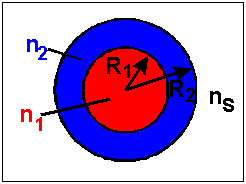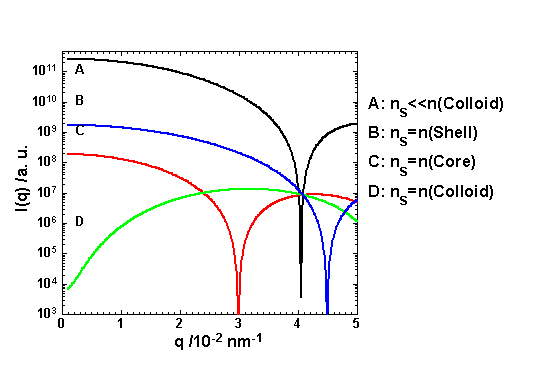Analysis of form factors
With a static light scattering instrument we can measure the form factor of highly diluted colloidal dispersions. The form factor P(q) for monodisperse homogeneous hard spheres is:

q is the wave vector, R is the radius of the sphere and nP and nS are the refractive indices of the spheres and the solvent. Independent of the contrast (nP-nS) the minimum of the form factor is at q*R=4,493. Due to the position of the minimum we determine the size of the colloids with this relation. In reality the colloids are not monodisperse and the minimum of the measured form factor is broader. From the width of the minimum we can determine the polydispersity s of the colloids.
For core-shell colloids the system is not homogeneous, because the refractive indexes of the core and shell are not equal. With the assumption of a two step refractive index profile n(r) (see figure below) the form factor P(q) is
 | for  |
Due to the refractive index profile the minimum of the form factor is dependent on the contrast. The following figure shows the form factor for different refractive indexes of the solvent (contrast variation).

With a high contrast (n(colloid)-nS) (curve A) we obtain the form factor of a homogeneous sphere. Is nS equal to the refractive index of the hole colloid (curve D), the forward scattering goes down (q=0) and the scattering intensity at higher q-values occurs due to the difference of n(core) to n(shell). In curve B n(shell)=n(solvent) and one finds the form factor of the core only. If nS is equal to n(core) (curve C) we obtain the form factor of a hollow sphere. One can see in this figure that all curves intersect in one point. For this point the relation q*R(shell)=4,493 is valid. From that position we can determine the size of the core-shell colloid.

